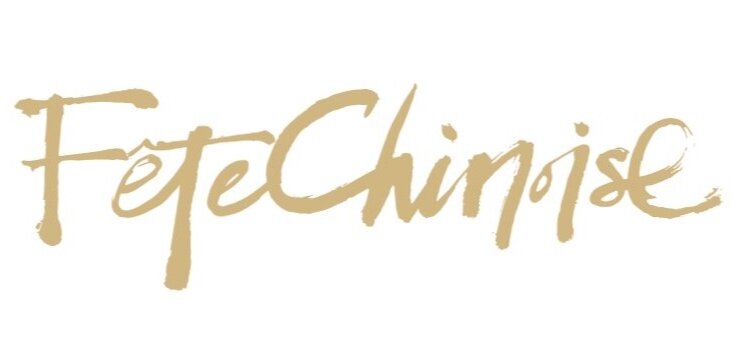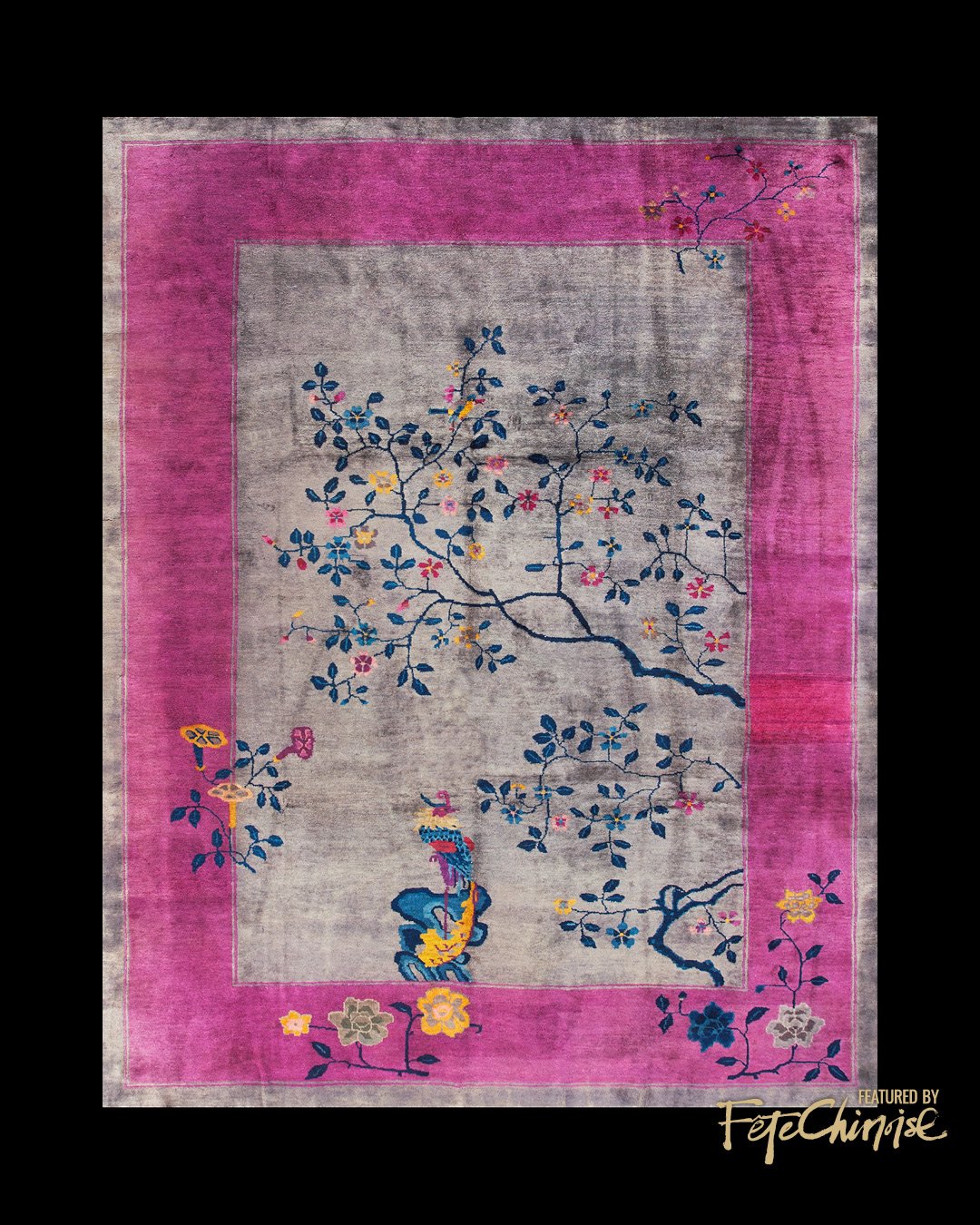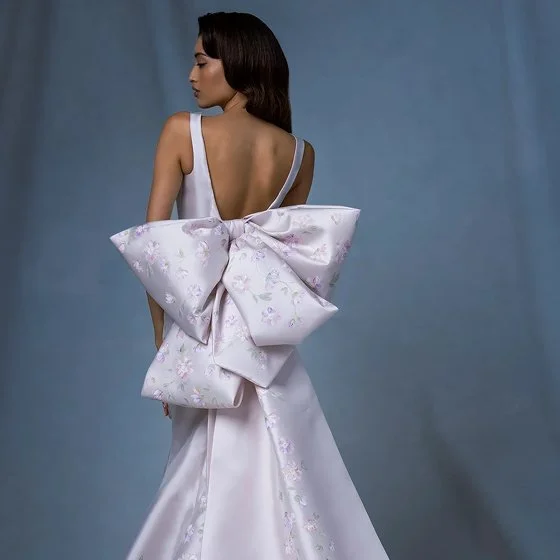Magic Carpet Ride 民國古毯價值重現
English 英: Deirdre Kelly · Chinese 中:Ophelie C.
Photos: provided by antique rug studio nyc & 1stdibs
Photos: antique rug studio nyc
談到傳統的名貴地毯,一般都只會聯想到波斯地毯;但當代巿場上的新寵,竟是上世紀二十年代天津製的中國古董地毯?全因它們造工細緻講究,經得起年月洗禮而歷久不衰,且圖紋用色構圖等帶當代藝術感,目前比波斯地毯更具投資價值。
Photo: antique rug studio nyc
“Rich, vivid jewel tones that reflect the opulence and abundance of the Jazz Age.”
Why it is so high in demand
What makes the rugs coveted is the versatility of their design. Unlike traditional ornate silk carpets, the deco rugs are bracingly spare. They display abstract and simplified motifs and patterns along with “rich, vivid jewel tones that reflect the opulence and abundance of the Jazz Age,” notes London interior designer Anouska Tamouny, who earlier this year sold a Chinese deco to a British client with a stately home filled with contemporary furnishings. Their embrace of minimalism, a Western artistic movement dating to the first half of the 20th century, make the rugs look fresh and versatile, even when nearly a hundred years old. “They fit more closely with the aesthetics of contemporary culture,” she says.
Photo: 1stdibs
這些百年古毯產於民國時期,由美國著名羊毛商人Walter Nichols 在天津設廠,所生產的地毯設計糅合歐亞現代藝術如印象派、立體派等風格,創新大膽。例如二十年代採用現代花卉取代傳統的菊花圖案以及萬字符邊框,三十年代則突破邊框界限,採用如龍鳳呈祥、梅花、或富有佛教或道教色彩的中式圖案。 Nichols更鼓勵客人按自己的審美眼光設計,打造獨一無二、糅合中西文化的另類風格。
Photo: antique rug studio nyc
每張地毯的用料講究,製作一絲不苟,採用極其密集無縫的機械紡紗技術,質感十足,每平方呎重達一磅。地毯色彩亦耀目亮眼,用上昂貴的德國人工染料,當年刊印的公司小冊子羅列多達八百種顏色供客人選擇。全盛時期在北京、上海、香港、倫敦和馬尼拉等地都設有陳列室,甚至遠售至加拿大。
Photo: antique rug studio nyc
western art movement influences
That Western influence is significant. Though manufactured in China, the rugs were not made for the Chinese people to enjoy. Starting in 1924, American wool merchant Walter Nichols, the best-known maker of Chinese art deco rugs, mass produced them exclusively for the Western market, using machine-spun yarn and in-house designers with knowledge of such European modern art movements as Impressionism, Fauvism, Cubism and Art Nouveau.
Photo: antique rug studio nyc
Some curvilinear design elements were borrowed from the Japanese-influenced French deco. Made at Nichols’ factory in Tianjin, a man-made port located south of Beijing, the rugs relied on German synthetic dyes in such eye-popping hues as emerald, turquoise, amethyst, citrine and coral. This set them apart from the more traditional blue-and-white Peking rugs which first appeared on the international market during the final years of the Qing dynasty at the dawn of the 20th century.
Photo: antique rug studio nyc
As the late carpet historian Elizabeth Bogen has observed, design motifs were different as well; modern florals and bamboo borders replaced the chrysanthemums and pearl or swastika borders of old.
然而這些珍品在過去東方一直被鑑賞家忽略和低估其價值,認為它不夠傳統色彩。倒是已故毛毯史學家 Elizabeth Bogen 獨具慧眼,透過嚴謹的學術研究發掘其文化底蘊,在論文指出這批古毯蘊藏中國當代的工藝技術。即使 Nichols 的地毯王國後來因二戰和大蕭條分崩離析,這門工藝仍得以延續,並以「天津地毯」之名繼續發展。
Sponsored by FERRIS WHEEL PRESS
Photo: antique rug studio nyc
A Brief History: Chinese Art Deco Rugs
Later versions from the 1930s tended to be borderless, with just a few sprays of flowers on a solid field. Other Nichols rugs displayed familiar Chinese imagery, including dragons, phoenixes, plum blossoms and symbols associated with Buddhism and Taoism. But the patterning was asymmetrical and often experimental, some of it requested by the buyers themselves. By the 1940s, much Chinese imagery was eradicated altogether. The tones also became more subdued with the approach of World War II.
Photo: antique rug studio nyc
Nichols actively encouraged customization. A company brochure he published in the 1920s detailed what a client could request for a carpet from a list of options including more than 800 colour choices. Nichols had showrooms in Shanghai as well as Peking, Hong Kong, London and Manila, to name just a few. His customers included individual homeowners as well as major department stores in the U.S. like Wannamaker’s and B. Altman.
As Nichols grew successful, he had many imitators, among them a fellow American named Helen Fette. A former Vassar-educated Christian missionary, she made rugs as part of her charity work. Her Peking-based Fette-Li company, formed in association with Chinese rug manufacturer Li Meng Shu, produced rugs similar in design to a Nichols Super Rug but the thinness of their cotton warp made them floppier. By comparison, Nichols’s tightly knotted rugs were so dense and plush that many weighed a pound per square foot. Both shipped tens of thousands of miles of carpets overseas, but Nichols is still considered the superior maker. “He started the whole process,” Hakimi says.
Photo: antique rug studio nyc
In 1935, Nichols fled the invading Japanese army, soon after bringing an end to his carpet production in Tianjin. After relocating back to the U.S., he declared bankruptcy after the Great Depression curtailed demand for decorative items for stylish American homes. But the high calibre of the wool he used practically guaranteed that the rugs would live on. Their beauty as a floor covering endures. And yet for years, the carpets were underrated by oriental rug connoisseurs who said that their art deco style made them culturally inauthentic and therefore unworthy of serious attention. Rug scholar Bogen disagrees.
新冠疫情期間百廢待興,唯獨這些古毯身價不跌反升。三年前,一般九呎乘十二呎的古毯價值已高達 $3,000 美元,如今更身價翻倍。從事古毯交易逾廿五年的 Ramin Hakimi 說:「這些色彩繽紛的中國古毯比傳統的波斯地毯更耐用、更符合當代審美觀……它們品質非凡,真的物有所值,因此非常渴巿。」
Photo: antique rug studio nyc
Influences on China
In a published paper on the decos, she highlighted the fact that while designed for Westerners, the rugs were made by local artists and weavers, making them, in her expert opinion, irrefutably Chinese. “These house artists were valued and well-paid employees,” she wrote, “often ranking just below the manager.” As well, the designers’ ability to combine European and Asian designs and palettes in a one-of-a-kind decorative product created a new school of rug production in China. Even after Nichols had long left the scene, rugs in the art deco style continued to be produced. They became known as Tianjin rugs, in reference to the place that first gave rise to them.
Photo: antique rug studio nyc
“In a contemporary style home, a colourful art deco sometimes works better than a traditional Persian rug. It’s more versatile. People are beginning to appreciate that.”
Chinese deco flourished the most between the wars in Shanghai where Jazz Age architecture can still be seen in buildings along the city’s waterfront. Revitalization projects launched around a decade ago have brought some of China’s own modernist heritage back to life, creating domestic demand for the deco rugs that were once exclusively shipped abroad. Young design-savvy Chinese are calling New York to get them. Hakimi, who has been dealing in Chinese art deco rugs for the last 25 years, says he now sells to China more than he ever did before. “In a contemporary style home,” he says, “a colourful art deco sometimes works better than a traditional Persian rug. It’s more versatile. People are beginning to appreciate that.”
Photo: antique rug studio nyc
Photo: antique rug studio nyc
古毯令人垂涎的原因,更因為其易於配搭,適用於不同設計風格亦不失違和感,突破傳統華麗絲綢地毯的局限。英國倫敦室內設計師 Anouska Tamouny 指出,天津地毯展示了抽象和簡約圖案,以及「豐富、生動的珠寶色調,反映了爵士時代的富裕和豐富」。早前她就把這中國裝飾融入一位英國客戶,充滿現代風格、簡約主義的家。Hakimi 分享道,原來這天津地毯潮不只在西方國家,不少中國新一代的設計師更遠道從美國,把這些一個世紀前僅限出口的中國傳統工藝品,重新發掘並帶回海外的家中。
enjoy more images of chinese art deco rugs
Photo: antique rug studio nyc
Photo: antique rug studio nyc
Photo: antique rug studio nyc
Photo: antique rug studio nyc
Photo: antique rug studio nyc
Photo: antique rug studio nyc
Photo: antique rug studio nyc
Photo: antique rug studio nyc
Photo: antique rug studio nyc
Photo: antique rug studio nyc
Photo: antique rug studio nyc
Photo: antique rug studio nyc
SPonsored by FERRIS WHEEL PRESS



































Remembering Stanley Kwok, visionary architect and urban planner who shaped cities for people, creating lasting community-focused spaces and inspiring future generations.